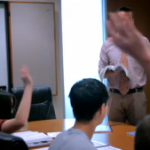The grammar section on the SAT puts even the strongest English speakers in fits over some of the shifty tricks they try to distract you from the clearest message. One of the most common types of errors on the SAT grammar section is subject-verb agreement. In the English language, when conjugating verbs it is imperative that you understand the quantity of the subject. Singular subjects are conjugated with singular verbs, and plural subjects are conjugated with plural verbs. Seems easy enough, right? Wrong! The SAT loves to throw roadblocks up in your way to keep you from properly identifying subject-verb agreement. Follow these few tips to keep from getting derailed.
Keep an eye out for collective nouns! Collective nouns are words like “group” or “team” or “university” that represent a large number of people, yet are themselves singular. Maybe there are twelve kids on the soccer team, but there is only one soccer team! Take a look at the following sentence:
The student body are very pleased to welcome a new faculty member.
This sentence is incorrect, because although the student body is made up of (presumably) multiple students, there is only one student body being referenced. Therefore, the sentence should be conjugated in the singular, like so:
The student body is very pleased to welcome a new faculty member.
Always check for prepositional phrases. A common strategy used by the SAT to trick you is to place a prepositional phrase in between the true subject of a sentence and the verb. Take a glance at the following sentence:
The group of children have never seen that movie.
This sentence is incorrect, because the subject of the sentence is actually “group”, which is a singular collective noun, rather than “children”, which is a plural noun. Therefore, the sentence should be conjugated in the singular, like so:
The group of children has never seen that movie.
Just because a noun doesn’t end in s, doesn’t mean it isn’t plural! Watch out for nouns like “children”, which although plural does not end in an s like most English plural nouns. There’s an exception to every rule, and make sure you are well versed in the nouns that are exceptions to typical conjugation. Take a look at the following sentence:
The fungi in shelves along the wall is growing nicely.
This sentence is incorrect because “fungi” is actually the plural form of the noun “fungus”. Because it is a plural noun, we must conjugate the verb in the plural as well. Corrected, the sentence will read:
The fungi in shelves along the wall are growing nicely.
Keep an eye out for these tricks on SAT day and you should fly through the grammar section!
By: Catherine Martin







